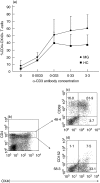Expression of OX40 (CD134) on CD4+ T-cells from patients with myasthenia gravis
- PMID: 16367941
- PMCID: PMC1809569
- DOI: 10.1111/j.1365-2249.2005.02955.x
Expression of OX40 (CD134) on CD4+ T-cells from patients with myasthenia gravis
Abstract
Myasthenia gravis (MG) is commonly regarded as the prototype of an antibody-mediated, organ-specific autoimmune disease. Antibodies against the acetylcholine receptor (AChR) on the muscle endplate trigger its typical clinical manifestations of weakness and fatiguability. T-B cell interactions are thought to play a crucial role in the pathogenesis of MG. OX40 (CD134), a costimulatory molecule that is expressed on activated CD4+ T-cells, might contribute to the development or pathogenesis of immune-mediated diseases such as rheumatoid arthritis and graft-versus-host disease. In the present study, we investigated the expression of OX40 on CD4+ T-cells from patients with MG and healthy individuals. Results from 36 MG patients and 28 healthy controls revealed that more freshly isolated CD4+ T-cells from MG patients expressed OX40 than cells from healthy individuals. High levels of antibodies against the AChR, thymic hyperplasia and onset at an early age were associated with elevated expression of OX40. Upon activation by various concentrations of anti-CD3 antibodies, CD4+ T-cells from MG patients showed a tendency toward higher levels of OX40 expression than cells from healthy individuals. Given the role of OX40 in the immune system, we conclude that OX40 might contribute to the development of MG.
Figures



Similar articles
-
CD134 expression on CD4+ T cells is associated with nephritis and disease activity in patients with systemic lupus erythematosus.Clin Exp Immunol. 2006 Aug;145(2):235-42. doi: 10.1111/j.1365-2249.2006.03141.x. Clin Exp Immunol. 2006. PMID: 16879242 Free PMC article.
-
Activation-associated phenotype of CD3 T cells in acute graft-versus-host disease.Clin Exp Immunol. 2006 Jul;145(1):36-43. doi: 10.1111/j.1365-2249.2006.03104.x. Clin Exp Immunol. 2006. PMID: 16792671 Free PMC article.
-
Expression of T cell activation antigen CD134 (OX40) has no predictive value for the occurrence or response to therapy of acute graft-versus-host disease in partial T cell-depleted bone marrow transplantation.Bone Marrow Transplant. 1999 May;23(10):1013-7. doi: 10.1038/sj.bmt.1701755. Bone Marrow Transplant. 1999. PMID: 10373067
-
Regulation of CD4 T cell memory by OX40 (CD134).Vaccine. 2006 Feb 13;24(7):872-83. doi: 10.1016/j.vaccine.2005.07.108. Epub 2005 Sep 7. Vaccine. 2006. PMID: 16176850 Review.
-
CD4+ T cells and cytokines in the pathogenesis of acquired myasthenia gravis.Ann N Y Acad Sci. 2008;1132:193-209. doi: 10.1196/annals.1405.042. Ann N Y Acad Sci. 2008. PMID: 18567869 Review.
Cited by
-
Regulatory T cells in multiple sclerosis and myasthenia gravis.J Neuroinflammation. 2017 Jun 9;14(1):117. doi: 10.1186/s12974-017-0892-8. J Neuroinflammation. 2017. PMID: 28599652 Free PMC article. Review.
-
The tumour necrosis factor/TNF receptor superfamily: therapeutic targets in autoimmune diseases.Clin Exp Immunol. 2011 May;164(2):145-57. doi: 10.1111/j.1365-2249.2011.04375.x. Epub 2011 Mar 14. Clin Exp Immunol. 2011. PMID: 21401577 Free PMC article.
-
Clinical Significance of OX40 and OX40 Ligand in the Peripheral Blood of Patients with Myasthenia Gravis.J Immunol Res. 2022 Feb 28;2022:4337399. doi: 10.1155/2022/4337399. eCollection 2022. J Immunol Res. 2022. PMID: 35265719 Free PMC article.
-
The OX40/OX40L Axis Regulates T Follicular Helper Cell Differentiation: Implications for Autoimmune Diseases.Front Immunol. 2021 Jun 21;12:670637. doi: 10.3389/fimmu.2021.670637. eCollection 2021. Front Immunol. 2021. PMID: 34234777 Free PMC article. Review.
-
OX40 Gene and Serum Protein Expression Profiles in Patients with Parkinson's Disease.Cell J. 2018 Jul;20(2):177-182. doi: 10.22074/cellj.2018.5038. Epub 2018 Mar 18. Cell J. 2018. PMID: 29633594 Free PMC article.
References
-
- Lennon VA, Lindstrom JM, Seybold ME. Experimental autoimmune myasthenia gravis: cellular and humoral immune responses. Ann NY Acad Sci. 1976;274:283–99. - PubMed
-
- Hohlfeld R, Kalies I, Kohleisen B, Heininger K, Conti-Tronconi B, Toyka KV. Myasthenia gravis: stimulation of antireceptor autoantibodies by autoreactive T cell lines. Neurology. 1986;36:618–21. - PubMed
-
- Wang XB, Kakoulidou M, Giscombe R, Qiu Q, Huang D, Pirskanen R, Lefvert AK. Abnormal expression of CTLA-4 by T cells from patients with myasthenia gravis: effect of an AT-rich gene sequence. J Neuroimmunol. 2002;130:224–32. - PubMed
-
- McIntosh KR, Linsley PS, Bacha PA, Bacha PA, Drachman DB. Immunotherapy of experimental autoimmune myasthenia gravis. selective effects of CTLA4Ig and synergistic combination with an IL2-diphtheria toxin fusion protein. J Neuroimmunol. 1998;87:136–46. - PubMed
-
- Croft M. Costimulation of T cells by OX40, 4–1BB, and CD27. Cytokine Growth Factor Rev. 2003;14:265–73. - PubMed
Publication types
MeSH terms
Substances
LinkOut - more resources
Full Text Sources
Other Literature Sources
Medical
Research Materials

